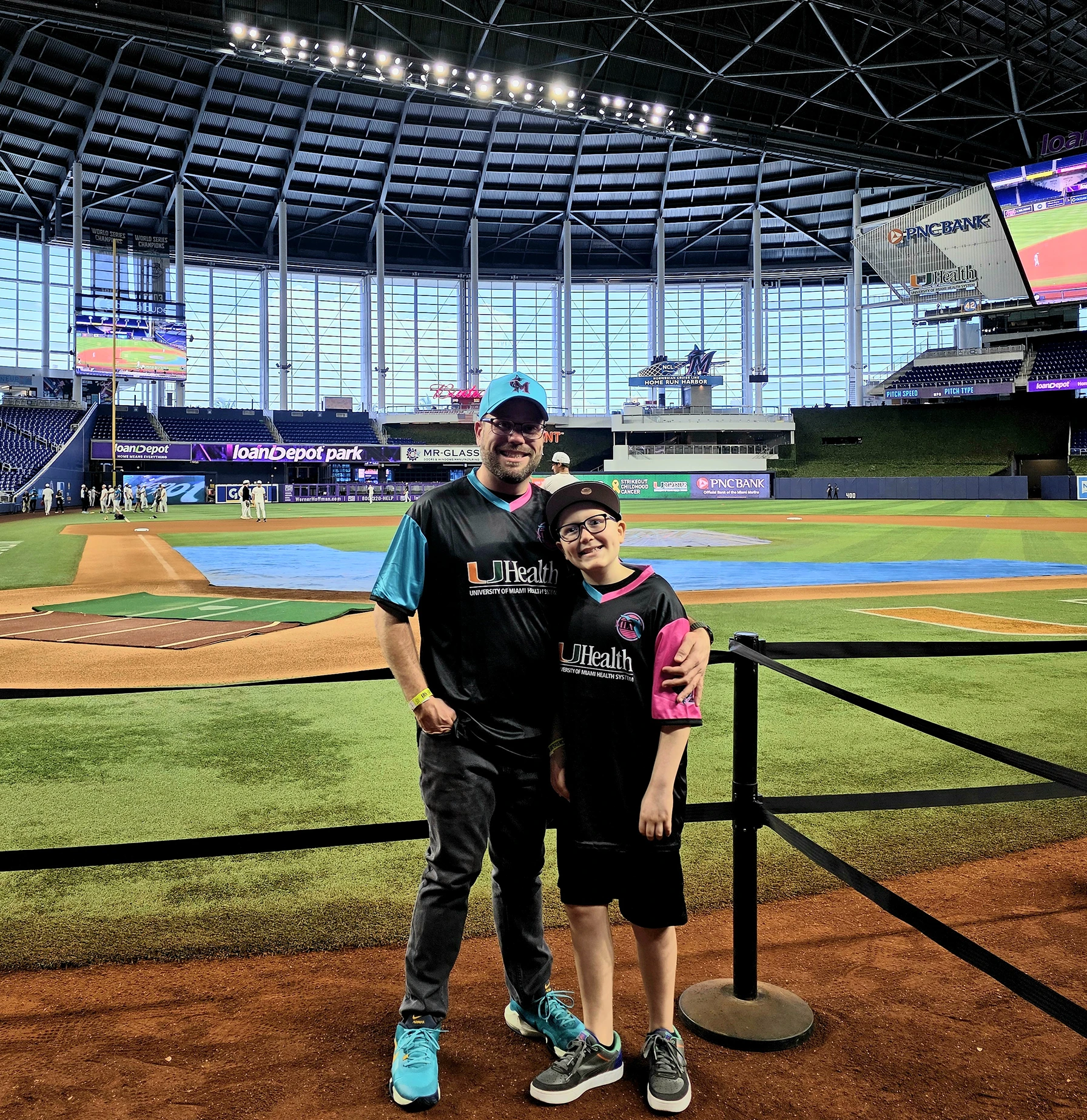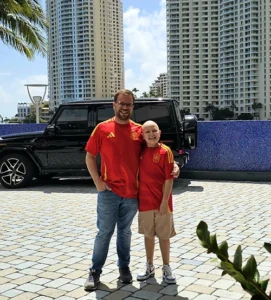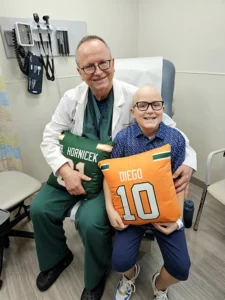Ewing Sarcoma: A Young Boy’s Battle for Better Treatment

When 10-year-old Diego Gonzalez experienced severe leg pain that persisted for months, his father, Javier Gonzalez, knew it had to be more than a simple sports injury or growing pains. An MRI from a pediatric orthopedic in Puerto Rico provided results that no parent ever wants to hear. Diego was diagnosed with Ewing sarcoma, a rare bone cancer that’s diagnosed in only about 200 to 250 young people in the United States each year.

“I get goosebumps every time I remember when we were called into the doctor’s office because this is something you never think you’re going to get told in your life that your son has cancer,” says Gonzalez.
Ewing sarcoma is routinely treated with chemotherapy. What differentiates care for this rare disease is radiation, surgery, or a combination of the two to supplement chemotherapy.
Gonzalez started researching the best surgeons for his son’s rare cancer and reached out to all of them. Francis Hornicek, Jr., M.D., Ph.D., director of orthopedic oncology at Sylvester Comprehensive Cancer Center, part of UHealth – University of Miami Health System, called Gonzalez immediately to set up a virtual appointment for the next day. “I remember we had 20 family members on the call, and as soon as he said he could biopsy Diego next week, my mom screamed out from the back that we’ll be there tomorrow,” says Gonzalez.
What is sarcoma?
Sarcoma is a rare and aggressive type of cancer that affects the bones or soft tissues, including cartilage, fat, muscle, or blood vessels. Diagnosis can take months because sarcoma comprises only around 1% of all cancers, and there is no way to screen for them.
Diego’s form of sarcoma, Ewing sarcoma, can occur at any age, but it’s typically diagnosed between ages 10 and 20. According to the American Cancer Society, about 200 to 250 young people in the United States are diagnosed with it each year.
How sarcoma is diagnosed
The first sign of sarcoma is often a non-painful lump or a bump on the arm or leg. It’s not uncommon for patients and physicians to remain unaware, and diagnosis can take months. Anything greater than a two-centimeter lump — about the diameter of a penny — could be a sarcoma and should be tested with a biopsy.
Additional symptoms can include
- Pain that worsens at night or during activity
- Unexplained fevers, fatigue, or weight loss
- Reduced mobility in an arm or leg
If these symptoms persist, especially if the pain worsens, consult your pediatrician. Early evaluation, including imaging tests and a biopsy, can lead to a faster diagnosis and better outcomes.
Diego’s case, where doctors assumed his leg pain was growing pains or a sports injury, is a common reason for a delayed diagnosis of Ewing sarcoma. Because his parents knew their son was in too much pain for simple growing pains, Diego accessed imaging and received a diagnosis before the cancer spread to other parts of his body.
Sarcoma treatment at Sylvester
Diego was treated with routine chemotherapy for Ewing sarcoma and had an excellent response. Next, he needed either surgery or radiation therapy to remove or destroy cancer cells.
When it comes to pediatric Ewing sarcoma cases, Dr. Hornicek tries to remove the cancer with surgery and avoid radiation whenever possible. Long-term side effects of radiation on the pelvic area of a child include the development of another sarcoma called radiation-associated sarcoma, bone growth impairment, nerve damage, bone weakness and hip deformity.

In Diego’s case, Dr. Hornicek was able to remove the cancer and reconstruct his pelvis in a 10-hour procedure.
“We were ready for him to lose a leg because we knew that was the result from other cases, but Dr. Hornicek gave him the chance to live a normal life again,” says Gonzalez.
Diego responded well to the chemotherapy. Dr. Hornicek expects he won’t need radiation.
“He’s doing well, knock on wood, and hopefully he’ll do well and never need radiation,” says Dr. Hornicek, who is co-leader of the Sarcoma Multidisciplinary Care Group and director of Chordoma Program and Spine Oncology at Sylvester, as well as chair of the department of orthopaedics at the University of Miami Miller School of Medicine.
Ewing sarcoma is extremely rare, so only a small number of hospitals in the United States have real expertise in treating it. Approximately 900 new sarcoma patients are treated at Sylvester a year, a large number for such a rare cancer.
With decades of experience, Dr. Hornicek has learned to carefully balance treatment options of surgery and radiation, ensuring patients have the best chance of beating the cancer while maintaining as much function and quality of life as possible. “If you were to amputate the whole pelvis, you may have a better oncologic outcome, but the functional outcome in terms of missing a lower extremity would be quite significant,” he says.
Ewing Sarcoma research happening in Miami
Researchers at Sylvester are among the few scientists and physician-scientists around the country focusing on it. Studies include research on hereditary genes for the disease, which could aid earlier detection and the development of treatments that may be more effective and less toxic.
While Diego was fortunate to respond well to chemotherapy, many patients experience drug resistance when cancer cells start to evade a previously effective medication.
Researchers at Sylvester are studying the causes of drug resistance and ways to prevent it to save more lives. “The reason why patients sometimes succumb to the cancer is that the drug we initially gave them that worked no longer works. So that’s one of our areas of focus,” says Dr. Hornicek.
In addition, researchers at Sylvester are running 13 clinical trials on sarcoma, including the only phase 1 trials in the southeastern U.S.
One notable area of research involves a protein called SIRT5, which Ewing sarcoma cells rely on for rapid growth. David Lombard, M.D., Ph.D., who co-leads Sylvester’s Cancer Epigenetics Program, identified ways to inhibit the growth of SIRT5. SIRT5 inhibitors have demonstrated promising results in laboratory models and may eventually progress to clinical trials.
“Our hope is that by manipulating SIRT5, we can develop treatment regimens that may have fewer long-term side effects for kids with Ewing sarcoma,” says Dr. Lombard.
Dr. Lombard’s research on Ewing sarcoma, which involves studying how to target SIRT5, has broader applications for other cancers, as well as for aging, metabolism, and stress.
“There’s a huge advantage to being treated at an academic medical center like Sylvester because you have access to leading-edge approved treatments, the latest medical knowledge and also to new clinical trials,” says Dr. Lombard.
Holding on to hope
Survival rates for Ewing sarcoma are excellent, with the five-year survival rate around 70–80% for patients whose cancer is limited to the affected area. The survival rate drops to around 30–40% if the cancer has spread.
When Gonzalez looks back on his family’s journey with Ewing sarcoma over these past several months, he’s especially grateful Dr. Hornicek was the first to fit his son in for an appointment. “The empathy he has with Diego is out of this world,” he says.
For Dr. Hornicek, responding to a desperate father immediately was simply the obvious choice. “I treat everybody like I’d want my family member to be treated, and if you do that, you usually make the right decision.”
Written by Wendy Margolin.
Tags: Bone cancer in children, Dr. David Lombard, Dr. Francis Hornicek, Rare cancer treatment
